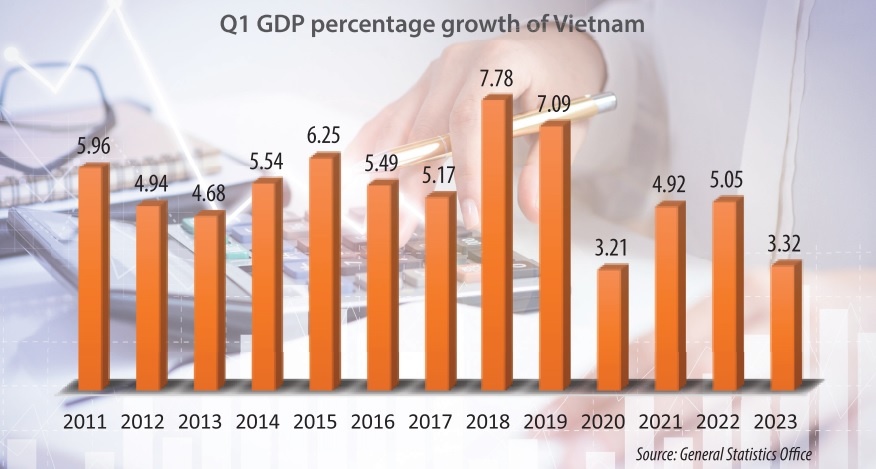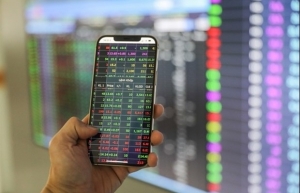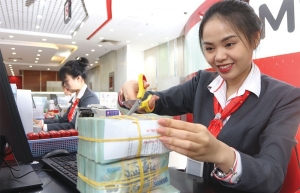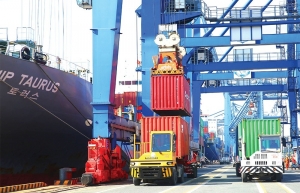Growth goals take hit after tricky Q1
Following months of halted operations due to social distancing in 2020 and 2021, a Dien May Xanh supermarket selling electronics and home appliances on Xuan La street in Hanoi’s Tay Ho district resumed business early last year, but sales are still slow.
“I think it will take time to recover the performance as the supermarket did in 2019 before the pandemic. Though our sales have begun to bounce back, they are still far lower than what we earned in the past,” a salesman at the supermarket told VIR. “Previously, we could sell dozens of TV per day, but the number is about two or three now.”
Most visitors now just come to look, not purchase. “I want a new TV and a new fridge, but I have no money for both. If prices were halved, I might consider,” said one visitor named Nguyen Van An, a factory worker at a Japanese electronics company based in Hanoi.
Another Dien May Xanh supermarket, located about 2km away, opened its doors in late 2021. In the first nine months of 2022, it saw many purchases a day. However, sales began to slow from last October. In the first three months of this year, sales were still moderate at best.
“Revenue is beginning to increase, though sales have yet to fully recover,” said a saleswoman at the supermarket. “Summer is coming, and it is expected that fans, air conditioners, and refrigerators will be our biggest sales.”
Not far away, the Vincom Plaza in Hanoi’s Bac Tu Liem district has seen a reduction in rental space. Unoccupied booths are seen in big numbers here. At the WinMart supermarket in the plaza, visitors are not as crowded as before, even during weekends. One saleswoman said that people were tightening their belts, and had already spent money in February for Lunar New Year.
 |
Sector reductions
The moderate situation at these supermarkets in the capital city reflects the dim landscape of Vietnam’s retail and consumption.
However, according to the General Statistics Office (GSO), the total retail and consumption revenue in the country for the first three months of this year hit $65.43 billion, up nearly 14 per cent. This includes $51.6 billion in retail revenue, up 11.4 per cent on-year.
Retail sales in Vietnam increased 11.3 per cent on-year in March 2023, slowing from a 13.2 per cent rise in February and a 20 per cent gain in January. This was the softest rise in retail trade since April 2022, amid rising cost pressures and higher borrowing costs.
Meanwhile, the on-year index for industrial production in Q1 is estimated to decline 2.2 per cent compared to the same period last year, when it rose 6.8 per cent on-year.
“This is due to the world economy continuing to face massive difficulties and unpredictable fluctuations, in addition to high inflation and reductions in enterprises’ orders and exports,” said GSO general director Nguyen Thi Huong. “Many key sectors in the economy are facing numerous difficulties which are expected to continue lingering in the months to come.”
In the first three months of this year, the mining sector fell 4.4 per cent compared to the corresponding period last year. The processing and manufacturing sector also dropped 2.4 per cent on-year, while the same period last year saw an on-year rise of 7.3 per cent. The electricity production and distribution sector also went down by 1 per cent on-year, versus an 8 per cent climb in Q1 2022. The reductions of these sectors have led to a big decrease in economic growth for Q1 2023.
Electricity of Vietnam (EVN) estimated that if the existing power price applied since 2019 continues to be kept, it will suffer from a financial loss of over $2.82 billion this year. The agony comes from a high rise in input material prices since early 2022, while the selling price of electricity has been kept unchanged since 2019.
In February, EVN produced a total of 20.2 billion kWh, up 9.4 per cent on-year. However, in the first two months, the volume hit 38.61 billion, down 2.2 per cent on-year. Last year, it suffered from a financial loss of over $1.3 billion due to a high increase in input material prices. EVN has proposed a power price hike in the coming months
Not only is the industrial production facing massive difficulties, but the business registration picture since early this year is also looking grey.
According to the GSO in Q1, there were nearly 34,000 newly established enterprises registered with nearly $13.5 billion and employing about 212,300 people – down 2 per cent in the number of enterprises, 34.1 per cent in registered capital, and 12.8 per cent in the number of employees compared to the same period last year.
If the newly added capital of $19.4 billion from 10,600 operational enterprises is included, the total new capital into the economy in Q1 of this year will be $32.9 billion, down 35.8 per cent on-year.
Bigger efforts needed
“We must make greater efforts to revive the economy. Low growth in Q1 means enterprises and people are still in big difficulties,” said Prime Minister Pham Minh Chinh.
The economy grew 3.32 per cent on-year in Q1, which is only higher than the 3.21 per cent rise of Q1 of 2020 in the 2011-2023 period (see chart). In which the agro-forestry-fishery sector grow 2.52 per cent – creating 8.85 per cent of economic growth; the construction and industrial sector declined 0.4 per cent – causing a 4.76 per cent reduction in economic growth; and the service sector climbed 6.79 per cent, responsible for 95.91 per cent of economic growth.
The government is expecting that Vietnam will be able to boost its tourism industry and attract more foreign direct investment – both key pillars for economic growth.
In 2019, the tourism industry created 9.2 per cent or $24.1 billion of GDP. Vietnam received a record 18 million foreign visitors in 2019.
Vietnam only received 3.6 million foreign tourist arrivals last year, around 70 per cent of its target. In Q1 this year, the figure has already hit nearly 2.7 million.
The GSO reported that in Q1 of 2023, total disbursement of foreign investment is estimated to be $4.32 billion, down 2.2 per cent on-year. Accumulatively as of March 20, 2023, total newly registered and newly added capital, and capital from stake acquisitions and capital contributions from foreign investors reached nearly $5.45 billion, tantamount to 61.2 per cent of that recorded in the same period last year.
According to global data analyst FocusEconomics, Vietnam’s economic momentum will likely soften this year as growth rates for consumption, exports and investment decelerate.
“However, an expansionary fiscal policy and China’s reopening should provide support, and Vietnam will likely remain ASEAN’s top performer in 2023. Foreign exchange fluctuations, monetary policy, banking liquidity and the property sector crunch are key factors to watch,” FocusEconomics told VIR. “Our panellists expect GDP to expand 6 per cent in 2023, and 6.5 per cent in 2024.”
The government expects that the economy will grow 6.5 per cent this year, meaning that more efforts are to be made in Q1-Q3.
 | Economic growth and market upgrade to draw capital The prospect of economic growth and market upgradation is the driving force to attract cash flow into the stock market. |
 | Pressure on to support new economic growth As the US Federal Reserve raised its benchmark interest rates by a quarter point to bring down inflation rate despite its recent signs of slowing and giving no real hint of a pause in hikes, the cycle is predicted to continue to run. |
 | High pedestal to reach for 2023’s growth ambitions A series of risks including a reduction in domestic production and global demand, and heightened geopolitical complexity are expected to make it more difficult for Vietnam to reach its economic growth indicators this year. |
What the stars mean:
★ Poor ★ ★ Promising ★★★ Good ★★★★ Very good ★★★★★ Exceptional
 Tag:
Tag:
Related Contents
Latest News
More News
- Global partnerships key to Vietnam’s IFC development (December 26, 2025 | 16:18)
- Vingroup pulls out of bid to invest in North-South high-speed railway (December 26, 2025 | 11:42)
- Strengthening supply chains through trade promotions and customs reform (December 24, 2025 | 14:00)
- PM orders investment model for North–South high-speed rail (December 22, 2025 | 17:43)
- LS Eco Energy to invest in Vietnam rare earth sector (December 22, 2025 | 17:31)
- Government moves to establish International Financial Centre (December 21, 2025 | 21:00)
- Vietnam's IFC to target global investment flows (December 21, 2025 | 18:00)
- Two national hospitals expand capacity with new facilities (December 20, 2025 | 09:00)
- Ha Tinh breaks ground on major Vingroup industrial and energy projects (December 19, 2025 | 18:24)
- EVN launches major power infrastructure projects nationwide (December 19, 2025 | 18:17)























 Mobile Version
Mobile Version